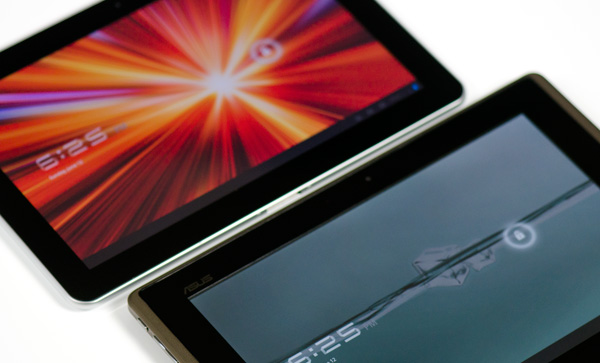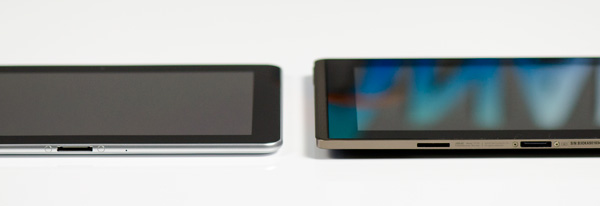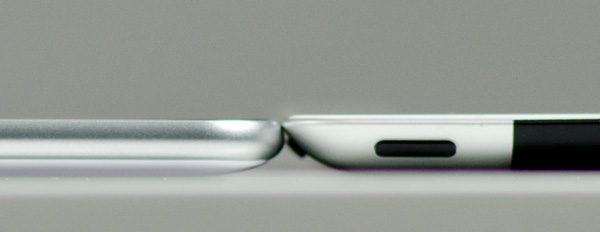Samsung Galaxy Tab 10.1 Review: The Sleekest Honeycomb Tablet
by Anand Lal Shimpi on June 13, 2011 5:07 AM EST- Posted in
- Tablets
- Samsung
- Tegra 2
- Galaxy tab 10.1
- Android 3.1
- Mobile
- NVIDIA
I remember standing in the audience of Samsung's CTIA press conference as it announced, for the first time ever, pricing and availability of its unreleased Galaxy Tab 10.1 and 8.9 before shipping. The smartphone (and early tablet) industries have gone this long without having to really compete based on price, mostly because in North America the carriers subsidize much of the cost. If every device costs $199 under contract, why get carried away with details like how much it actually costs?
The Galaxy Tab however was playing in a different space. While Apple ultimately caved to the pressures of carrier subsidies with the iPhone, the iPad remains completely unsubsidized and its followers buy it by the millions. The magical price point is $499 and it was at Samsung's CTIA press conference that it announced it would be matching Apple's $499 price point, and even dropping slightly below it for the 8.9-inch version.
At the time it seemed like a bold move, enough to give Honeycomb the fighting chance it needed. The Galaxy Tab would be thinner and lighter than the iPad 2 but competitively priced as well. This wouldn't be another Xoom.

Samsung Galaxy Tab 10.1 (top) vs. ASUS Eee Pad Transformer (bottom)
Then ASUS showed up. At $399, the Eee Pad Transformer not only offered a different usage model to the iPad and Galaxy Tab, it brought a lower price tag as well. Availability has been slim thanks to component shortages, but with the Eee Pad selling for $399 the Galaxy Tab at $499 all of the sudden seems overpriced.
| 2011 Tablet Comparison | ||||||
| Apple iPad 2 | ASUS Eee Pad Transformer | Motorola Xoom WiFi | Samsung Galaxy Tab 10.1 | |||
| SoC | Apple A5 (Dual ARM Cortex A9 @ 1GHz) | NVIDIA Tegra 2 (Dual ARM Cortex A9 @ 1GHz) | NVIDIA Tegra 2 (Dual ARM Cortex A9 @ 1GHz) | NVIDIA Tegra 2 (Dual ARM Cortex A9 @ 1GHz) | ||
| GPU | PowerVR SGX 543MP2 | NVIDIA GeForce | NVIDIA GeForce | NVIDIA GeForce | ||
| RAM | 512MB | 1GB | 1GB | 1GB | ||
| Display | 1024 x 768 IPS | 1280 x 800 IPS | 1280 x 800 | 1280 x 800 PLS | ||
| NAND | 16GB | 16GB | 32GB | 16GB | ||
| Dimensions | 241.2mm x 185.7mm x 8.8mm | 271mm x 175mm x 12.95mm | 249.1mm x 167.8mm x 12.9mm | 256.6 x 172.9 x 8.6mm | ||
| Weight | 601g | 695g | 730g | 565g | ||
| Price | $499 | $399 | $599 | $499 | ||
Based on specs alone you'd be right. Samsung's Galaxy Tab 10.1 has the same NVIDIA Tegra 2 tablet SoC inside,
1GB of LPDDR2 and 16GB of NAND on-board. You get a 10.1-inch 1280 x 800 PLS display and 802.11n WiFi support. It's worth pointing out that we're now well into the month of June and NVIDIA continues to be the only SoC vendor shipping in Honeycomb tablets. Samsung originally had plans to ship its own Exynos SoC in the Galaxy Tab but Tegra 2 remains the port of choice for all Honeycomb vendors at this point. Whether or not NVIDIA can win twice in a row with Ice Cream Sandwich later this year remains to be seen.

Samsung Galaxy Tab 10.1 (left) vs. ASUS Eee Pad Transformer (Right)
Where Samsung gives you something more for your money is in build quality and form factor. While Eee Pad Transformer feels surprisingly good for a cost reduced tablet, it doesn't feel nearly as slim or portable as the Galaxy Tab 10.1. It's no wonder Samsung went back to the drawing board on this one, the result is something that in many ways feels better than the iPad 2.
Apple still gets the nod in terms of quality of materials. The aluminum back of the iPad 2 is unbeatable. The Galaxy Tab 10.1 however feels lighter, a bit more rugged (I'm less concerned about scratching plastic than I am marring aluminum) and a little more comfortable to hold as a result. Against the Eee Pad there's no competition. I can live with the Eee Pad, but I much prefer the feel of the Galaxy Tab 10.1. The new Tab just feels like a device from this year - a compliment that, until now, I had only given to Apple.
The Galaxy Tab 10.1 measures just 8.6mm thick, 0.2mm thinner than the iPad 2. To be honest you really can't tell the difference, both devices feel thin. Ever after holding them back to back it's near impossible to tell that Samsung has built a thinner device. The most tangible difference in feel is the weight, not just in overall mass but in terms of weight distribution. The Galaxy Tab seems to carry the weight a bit better than the iPad, a bit more evenly.

Samsung Galaxy Tab 10.1 (left) vs. Apple iPad 2 (right)
Now is as good a time as any to point out that although Samsung calls this the Galaxy Tab 10.1, it's really the new Galaxy Tab 10.1. Originally Samsung announced a much thicker version at Mobile World Congress, a month prior to the CTIA announcement. With the much thinner iPad 2 hitting the market after the original 10.1 announcement, Samsung scrapped plans for the original and unveiled the thinner 8.6mm version as the new Galaxy Tab. The original Galaxy Tab 10.1 is now known as the Galaxy Tab 10.1v.












108 Comments
View All Comments
ph00ny - Monday, June 13, 2011 - link
Based on the fact that transformer has sold over 300k units, consumer interest is definitely thereheadbox - Monday, June 13, 2011 - link
those numbers can be misleading- that could be the number ordered by retail stores, and they could all be sitting on the shelf.ph00ny - Monday, June 13, 2011 - link
How is that misleading? It seems to fit with the fact that most store had it backordered for quite some timevision33r - Friday, June 17, 2011 - link
I think the Transformer sales has just peaked. The device is now available everywhere for retail and no mark up.They had to run a discount package for the Asus EEE pad yesterday on Ebay just to push the thing.
Since March, you can't even consistently find an IPad 2 in store.
JoeTF - Sunday, June 19, 2011 - link
Uhm, well, Transformer, after 3 months is still in constant state of out of stock and well on track to hit 1m units this summer. In total, they're aiming to sell 3.5m units before new model is unveiled in in December.It's just that in comparison - Samsung tablet is worst of all:
-plastic finish
-no USB
-no HDMI
-no sd card slot
-no user replaceable battery
-lack of single distinguishing feature (battery dock, or phone hybrid mode)
AlterEcho - Tuesday, June 14, 2011 - link
I do not agree that a 8.9" form factor is optimal. Most of my customers are shooting for the 10.1". So far, LTE and the smaller form factor is a non-starter. My clients are screaming for the Asus and 3G. They are more concerned with network coverage and reliability than a bump in speed. And I have to agree with them.Here are some reasons I am hearing in the field:
1) LTE only means that I will hit my cap faster and if they are complaining about a few users affecting bandwidth now, how are they going to handle faster speeds.
2) They should be worrying about coverage, not trying to increase speed. Speed does me little good if I do not have a reliable connection.
3) Why would I pay $500 for a giant "iPod"? $400 and a keyboard option allows me to type or disconnect and head to a meeting with pad-in-hand.
4) The smaller pad makes web pages feel 'scrunched' and busy. The larger one allows me to type easier as well as handle websites, better.
So for my customers, the larger form factor, 3g and $400 is the big seller. I think manufacturers (and us tech guys) forget about what is important to non-technical users. Price and size, IMHO, will be a significant driving factor. And I bet dollars to donuts that the Asus will outsell the Samsung...and even affect the iPads numbers. The price difference is to hard to ignore, in this economy.
JasonInofuentes - Monday, June 13, 2011 - link
Play nice! :)vision33r - Monday, June 13, 2011 - link
With those specs, yes they will only sell hundreds with the iPad 2s number it will sell millions.It's such a joke for these companies to use a Tegra 2 dual core that some single core beats it. The game performance is a joke consider the iPad 2's GL performance spanks it silly.
Even though the Tab has higher res but once you play an iPad 2 game on TV at 1080p with the HDMI cable it just makes these Android tablet look completely like a joke.
DigitalFreak - Monday, June 13, 2011 - link
"It's such a joke for these companies to use a Tegra 2 dual core that some single core beats it."Gotta love fanboys who don't have a clue about the product they're shilling. The iPad2 has a dual core processor.
headbox - Monday, June 13, 2011 - link
Maybe he's saying iPad 1 still beats it in key areas like battery life.